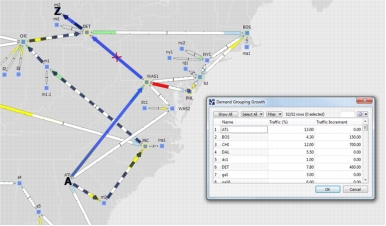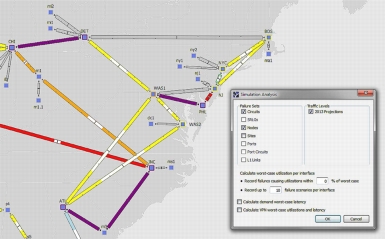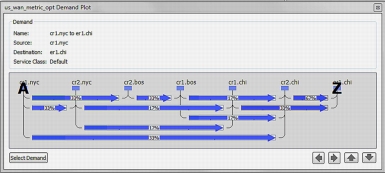|
|
Product Overview
• Maximize your network investments and reduce capital expenditures (CapEx) and operating expenses (OpEx) through capacity planning, failure analysis, and traffic engineering.
• Get precise modeling of complex networks, taking into account settings and configurations for Interior Gateway Protocol (IGP), Resource Reservation Protocol - Traffic Engineering (RSVP-TE), quality of service (QoS), Layer 1, VPN, multicast, and Border Gateway Protocol (BGP).
• Extensive modeling capabilities for simulating network availability and failover scenarios (Figure 1).
• Superior simulation performance and metric analysis of multicore platforms.
• Automated and intelligent traffic balancing and capacity optimization.
• Comprehensive forecasting based on traffic trends, external network influences, regional growth, and a variety of other inputs.
• Ability to combine multiple data sources to construct an end-to-end traffic matrix with the patented Demand Deduction feature.
• Interactive workflow with powerful filters and context-sensitive network display.
• Ability to easily store, retrieve, and share network plans through a web-accessible plan file database.
• Proven carrier-class scale, open APIs for OSS management integration.
• Superior, fully-functional and intuitive GUI.
Figure 1. Forecasting Link Utilization and Traffic Routing Under Failure Conditions

MATE Design Use Cases
• Simulate the impact of circuit, node, Layer 1, and other network component failures on traffic delivery and service-level agreements (SLAs).
• Model complex routing and failover policies with user-defined, advanced-routing external endpoints.
• Right-size circuits and modify topology as part of capacity planning for future network expansion.
• Observe the impact of rolling out new services or adding customers to the production network.
• Maximize existing capacity by using offline traffic engineering to adjust label switched paths (LSPs) and interface metrics.
• Analyze the vulnerability of network elements from high-priority VPNs to fiber cuts (Shared Risk Link Groups [SRLGs]).
• Analyze network QoS design to determine whether queues share capacity as intended under a range of failure and traffic scenarios.
• Model IP/MPLS Fast Reroute (FRR) Label Switched Paths (LSPs) node or link protection scenarios.
• Help to ensure explicit, redundant paths with LSP and the Point-to-Multipoint (P2MP) LSP explicit path initializer.
• Design and validate "greenfield" networks.
• Facilitate risk-free operations when removing network components from service during maintenance.
• Cost modeling: estimate the monetary cost of a network design, demand or group of demands.
MATE Design Solution
Figure 2. Failure Analysis Capabilities

Figure 3. Detailed View of Simulated Traffic Distribution

• Create baseline demands using highly accurate traffic matrices.
• Predict the impact of future traffic growth on the network infrastructure.
• Simulate how failures affect the network and whether bottlenecks will occur.
• Simulate user-specified policies to isolate worst-case impact on bandwidth utilization and latency, including VPNs.
• Identify how service classes and interface queue policies affect traffic distribution.
• Balance traffic loads across the network, optimizing utilization of the most expensive links.
• Explore the impact of moving traffic from one circuit to another.
• Optimize IGP metrics and link state packets
• Create fully explicit paths between specified LSPs or P2MP LSPs.
• Change IGP metrics to reroute traffic and observe impact.
• Model Fast Re-Route (FRR) LSP node or link protection scenarios
• Simulate how a Layer 1 topology change affects Layer 3 design.
• Evaluate requirements for express routes and resilient Layer 1 circuit routes using routing and explicit path constraints.
• Improved Layer 1 circuit routing with Simulated Constrained Shortest Path First (CSPF) like properties, to route Layer 1 circuits according to available link capacity.
• Verify complex inter-AS routing policies and BGP peering agreements.
• Graphically view traffic utilization along any path, indicating traffic demands at any point in the network.
• Create and share customized visualization layouts.
• Create and manipulate new network objects graphically or programmatically, including assigning properties.
• Assign site locations based on longitude and latitude, align sites, and segregate edge devices.
• Apply appropriate backgrounds, such as schematic and geographic, offering multiple views of the same network from high-level representations to OpenStreetMap details.
Network Discovery with MATE Collector
System Requirements
Ordering Information